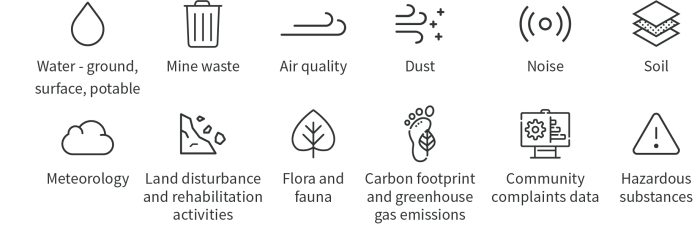Top 3 ways Canadian mining companies are getting ahead using environmental data management systems
Mining and resources companies in Canada face some of the most complex and rigorous environmental reporting standards. Federal regulations such as the National Pollutant Release Inventory (NPRI) and GHG Reporting establish a baseline for companies to report on their environmental impact.
However, companies operating across multiple sites in different provinces must also comply with varying local reporting standards, permit, formats and thresholds, creating a patchwork of obligations that can be difficult to manage.
Leading mining companies are using environmental data management systems to get ahead, not only to remain compliant but to drive operational efficiency and build trust. Here are the top three ways that Canadian mining companies are leveraging their environmental data management system to get ahead:
1. Establishing a single source of truth
For Canadian mining companies managing operations across multiple jurisdictions, environmental data can quickly become an administrative headache to manage, and keep on top of, and a compliance risk.
Relying on multiple platforms to manage disparate data sources limits visibility across operations and monitoring programs. Without a single source of truth, teams are forced to work reactively, addressing issues only after they occur.
A single source of truth is no longer a nice-to-have, it’s business-critical.
A robust environmental data management system can ingest and validate data from labs, field devices, sensors and other monitoring programs, all at different times and in different formats.
This enables environmental professionals to see in almost real-time:
- when data was collected,
- where it came from,
- how it was acquired and in what frequency, and
- who handled it along the chain of custody.
Beyond improving visibility, a centralised system supports data traceability, improves data quality and ensures consistent reporting across operations. High-performing systems can also retain critical metadata, such as instrument calibration records, depth measurements and original observations.
Canadian miners can ensure the consistency, quality and usability of all their environmental data for reporting and confident decision-making using a single source of truth.
2. Automating where possible
When working with environmental data, automation plays an important role in helping Canadian mining companies stay responsive and meet obligations without being buried in manual data handling processes.
If your team uses manual processes and spreadsheets to load, clean, and interpret data, you’re exposing your operation to delays, inconsistencies and reporting risks. Manual data handling not only slows down analysis, but it also increases the potential for human error and makes it harder to maintain a clear line of sight across your environmental obligations.
These issues often become more visible and problematic around reporting time, especially when data is missing or incomplete.
Companies are staying ahead by ensuring that their environmental data management systems can automatically ingest data from different sources without the need for manual manipulation, reformatting or reconciling mismatched naming conventions.
Environmental data management systems also allow users to set up automated alerts and triggers. If data is missing or indicates a potential non-compliance event such as an exceedance, the right people can be notified at the right time to ensure the company remains compliant and that the appropriate actions are followed in response to these events.
This response can transform companies from reacting to failed compliance checks to taking proactive measures to manage compliance status, and the ability to make effective and confident decisions anytime, anywhere.
The more your environmental data management system can handle automatically, the more value it delivers over time.
3. Improving visualisation and integration
As scrutiny from regulatory bodies and local communities increases, Canadian miners are using environmental data management systems to help them visualise and integrate environmental data into business-wide systems.
Relying on spreadsheets and manual data manipulation to report on sustainability metrics such as waste or emissions can slow down internal reporting processes and limits your ability to respond quickly to stakeholder demands. Delays and inconsistencies in reporting can erode trust and reduce your organisation’s agility over time.
Your environmental data management system shouldn’t be a black box. Companies are getting ahead of their reporting obligations and community scrutiny by using systems that allow environmental data to seamlessly integrate into dashboards, reports and other business systems, without manual exports or other intermediary manipulations.
Automated integrations and scheduled reporting empower teams to deliver timely, accurate, and consistent updates to regulators, investors, community stakeholders and internal decision-makers. This reduces the reporting burden, enhances transparency, and strengthens your social licence to operate.
How EnviroSys can help your company get ahead?
Leading Canadian mining companies are using environmental data management systems, such as, to manage complex environmental reporting obligations and proactively reduce their environmental impact.
EnviroSys is acQuire’s quality and compliance-focused environmental data management system built to efficiently capture, validate, monitor, analyse and report any type of environmentally-related data. It provides a single source of truth across your mining operations and can be configured to automate the collection and validation of data, as well as support real-time visualisation and workflows.
This frees up your team to focus on managing environmental risks and making informed decisions that protect both your operations and the environment.
Your three key takeaways
What environmental regulations do Canadian mining companies need to follow?
Canadian miners must comply with federal regulations like NPRI and GHG Reporting, as well as specific provincial standards depending on where they operate.
How can environmental data management systems reduce compliance risk?
These systems provide automated alerts, real-time monitoring, and traceable data to ensure timely and accurate reporting.
Is EnviroSys suitable for multi-site operations?
Yes, EnviroSys is designed to handle complex, multi-jurisdictional environmental data requirements across multiple Canadian provinces.



